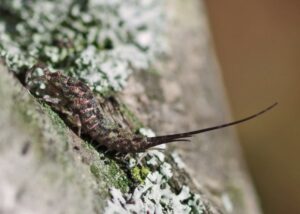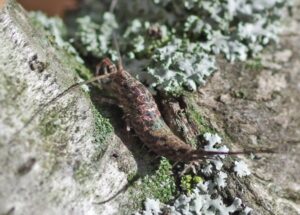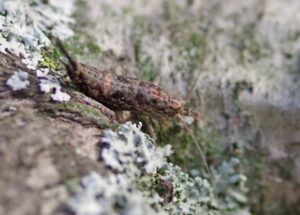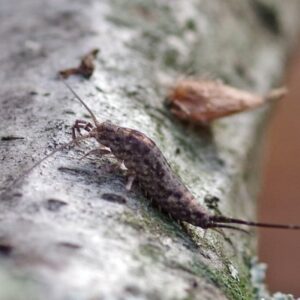Note: All links leave to external sites.
Salutations, BugFans,
The BugLady has been busy – here’s a slightly-spruced-up version of an episode that she posted 10 years ago. The Jumping bristletail that inspired it remains the only one she’s ever seen.
It was found by accident, as many good things are, clinging to one end of a branch that was lifted from the forest floor to get a better view of the mushrooms growing on it.
It turned out to be one seriously ancient critter. Insects probably got their beginnings 443 to 417 million years ago (mya) during the Silurian Period (for a long time it was believed that insects descended from the millipede/centipede bunch, but evidence now points to origins within the Crustacea). The oldest insect fossil (so far) is a “sort-of-silverfish” that dates back 396 million years to the Devonian Period. There are fossil springtails from that period, too, but springtails are not considered insects any more. The Carboniferous Period (354 to 290 mya) was marked by dragonflies with three-foot wingspreads and by an abundance of cockroaches. Tracks of Jumping Bristletails have been found in Permian rock (290 to 248 mya) (the upstart dinosaurs didn’t appear until the Triassic Period, some 50 million years later, plus-or-minus).
Jumping bristletails used to be classified with the silverfish (the blameless Jumping bristletail is still lumped with silverfish on some exterminator’s websites), but now they’re in their own order. In defining an animal scientifically, the groupings move from the most general umbrella to the most specific umbrella. Kingdom (Animalia) comes first, the biggest umbrella, then Phylum (Arthropoda), then Class (Insecta), then Order, then Family, Genus, and finally Species.

Jumping bristletails have two different order names. The newer name is Microcoryphia (“small head”), and the older appellation is Order Archaeognatha (“ancient jaw”), which refers to the way the mandible connects to the insect. Whichever order name you pick, Jumping bristletails are alone in it. That 396 million year old “silverfish” had the new-fangled double-jointed (dicondylic) mandible, but Jumping bristletails have the original equipment, a single (monocondylic), knuckle-like joint/articulation that allows its mouthparts to rotate or twist. Ancient insect jaws probably resembled those of Jumping bristletails, but most insects developed from a side branch that sprouted from the insect family tree early on. Some scientists consider the Jumping bristletail to be the least evolutionarily changed of any living insect – a chip off a very old block.
There are two Jumping bristletail families worldwide, the largest of which is Machilidae. Both families occur in North America, as do about two dozen of the 350 to 450 species of the world’s Jumping bristletails (we even have an introduced species).
(No – the BugLady is not going to try to name a genus or species for this one, but if she was a betting woman, she’d put a little money on Pedetontus saltator.)
Back in the (Permian) day, there were many wingless insects. Today, the vast majority of insects have wings, and many of those that have wings have two pairs of them. Most of the species that are wingless derive from ancestors that once had them. Not so the Jumping bristletail and the silverfish, who are primitively/primarily wingless – their ancestors never enjoyed flight.

As a group Jumping bristletails are drab (though a close look may reveal a variety of color patterns, and the BugLady’s bristletail is downright iridescent), scale-covered, cylindrical, hump-backed (silverfish are flat), and generally less than three-quarters of an-inch long. At one end they have sensory antennae and both simple and compound eyes (with their simple eyes, silverfish are blind to all but light and dark), and at the other end, three caudal filaments – two sensitive cerci and a central terminal filament. Fringes of hairs on the rear filaments explain the “bristletail” part.
They have the requisite six legs, but attached to the underside of some abdominal segments are additional pairs of short, moveable appendages called “styli” (plural of stylus) that serve as sensors of their substrate and that may be vestigial legs left over from their ancestors. Jumping bristletails dehydrate easily and must absorb water from their environment through tiny, paired sacs that are located on several abdominal segments and that work like pockets turned inside out (OK – “membranous, eversible sac-like vesicles”). Here’s an article with pictures showing their iridescence and a video of bristletails in action.
As their name suggests, they jump – six inches and more – which silverfish can’t do. This they accomplish by pushing up with their legs while contracting the muscles in their abdomen to arch their body downward. They can run fast, too. Jumping is their main defense, but like silverfish, a dense covering of scales renders them slippery and helps them escape from the clutches of their predators.
In the “Is There a Video of That?” category (and there undoubtedly is one), consider Stephen P. Yanoviak’s research that looked at Jumping bristletails for clues to the evolution of insect flight. When a Jumping bristletail leaps from tree to tree, its drop is augmented by “steering,” using the long terminal filament (“directed aerial descent”) (kind of like a flying squirrel). Yanoviak dusted Jumping bristletails with orange fluorescent powder and dropped them from branches high in rainforest trees. Results showed that the filament was vital to a successful glide and landing, and Yanoviak suggests that because these wingless, arboreal insects had “flight” under control, winged flight probably originated from terrestrial insects.

Jumping bristletails live in a wide variety of conditions, from Arctic to desert, and they especially like leaf litter, bark, rock crevices, and rocky seashores. The North Carolina State University Entomology Pages rank Jumping bristletails as “common in grassy or wooded habitats.” They are found in the nooks and crannies of the world, where they shelter during the day and from which they perambulate at night. They rarely come indoors.
Herbivores and decomposers/recyclers, they use their mouthparts to feed on algae, fungi, lichens, mosses, and soft, decaying organic material, though a few sources said that they eat tiny invertebrates, too (one source said that they pick at their food rather than chewing it). They don’t/can’t bite people. They are eaten by birds, centipedes, spiders, mites, ants, and flies.
Ancient mouth; ancient winglessness, ancient reproduction, and ancient metamorphosis. Males court, sometimes with elaborate dances, then leave a sperm packet for her to pick up (indirect sperm transfer). She may lay as many as 30 eggs, but to lay more, she must dance again. Some species skip the dance and reproduce by parthenogenesis – females reproduce without input from males. Young Jumping bristletails have an ametabolous development – they start as miniatures of the adults and simply grow, shedding eight times over the course of about two years before reaching adulthood. Unlike most other insects, they continue to shed as adults and may live for two additional years. Each time they molt, they must first cement themselves to the substrate – a stick, rock, etc. – using fecal material as a glue. Should the glue fail, the insect will not molt, but die.
Interesting Jumping bristletail facts:
- Take yourself to a woodland some night and shine a flashlight on a spot in the leaf litter – Jumping bristletails are attracted by light and will appear after about 15 minutes. Their eyes will glow in the flashlight’s beam.
- According to a blog called “myrmecos” by entomologist and photographer Alex Wild, “In California these flightless insects are common around harvester ant nests. I don’t think they have any sort of specialized relationship with ants, except perhaps finding the warm microclimate of the mound surface agreeable.”
Small, yes. Old, oh yes. But not uncomplicated.
The BugLady
PS – Road Trip!!!!
